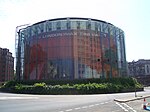The London Studios

The London Studios (also known as The South Bank Studios, The London Television Centre, ITV Tower, Kent House and LWT Tower) in Waterloo, Central London was a television studio complex owned by ITV plc and originally built for London Weekend Television. The studios were located in Central London, on the South Bank next to the IBM Building and the Royal National Theatre. The building was set on 2.5 acres of land and was 24 floors high. The London Studios closed on 30 April 2018. Many ITV programmes now come from BBC Studioworks' facility at the former BBC Television Centre, White City, London. The facilities were the main studios for ITV, along with a number of production companies including ITV Studios and Shiver based in Kent House tower, while the studios were home to many entertainment, game and daytime shows. These included Good Morning Britain, The Graham Norton Show, Ant & Dec's Saturday Night Takeaway and The Jonathan Ross Show. The studios were also used for other programmes from various other channels including BBC Television and Channel 4. ITV Creative, which promotes programmes on the ITV network, was also based at the London Studios.
Excerpt from the Wikipedia article The London Studios (License: CC BY-SA 3.0, Authors, Images).The London Studios
Upper Ground, London Lambeth (London Borough of Lambeth)
Geographical coordinates (GPS) Address Phone number Website Nearby Places Show on map
Geographical coordinates (GPS)
| Latitude | Longitude |
|---|---|
| N 51.50733 ° | E -0.11237 ° |
Address
IBM
Upper Ground 76-78
SE1 9PZ London, Lambeth (London Borough of Lambeth)
England, United Kingdom
Open on Google Maps










